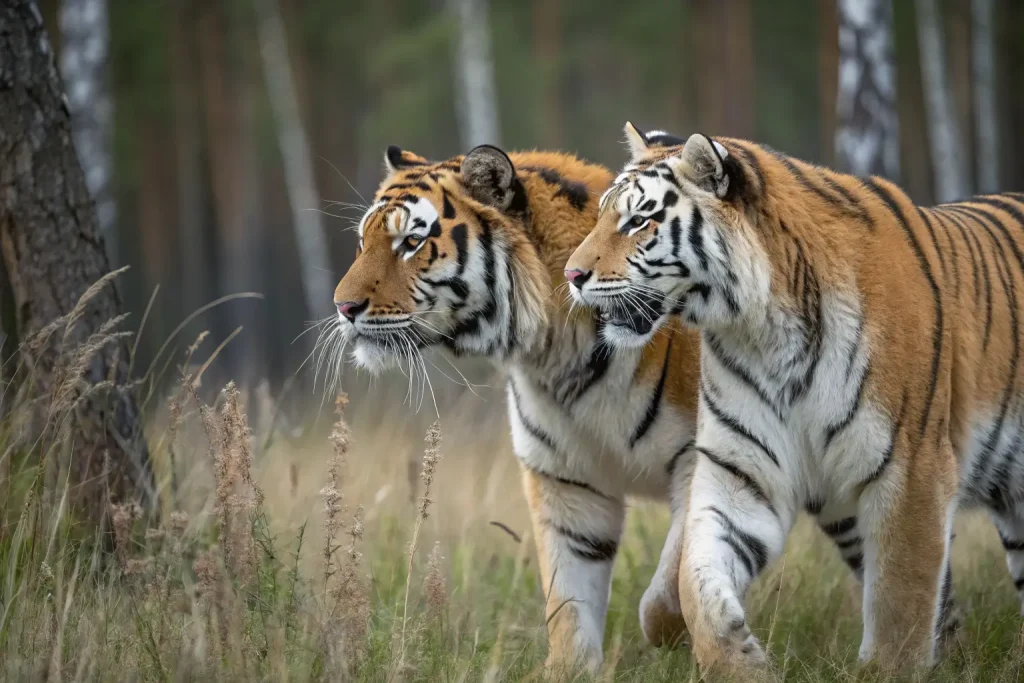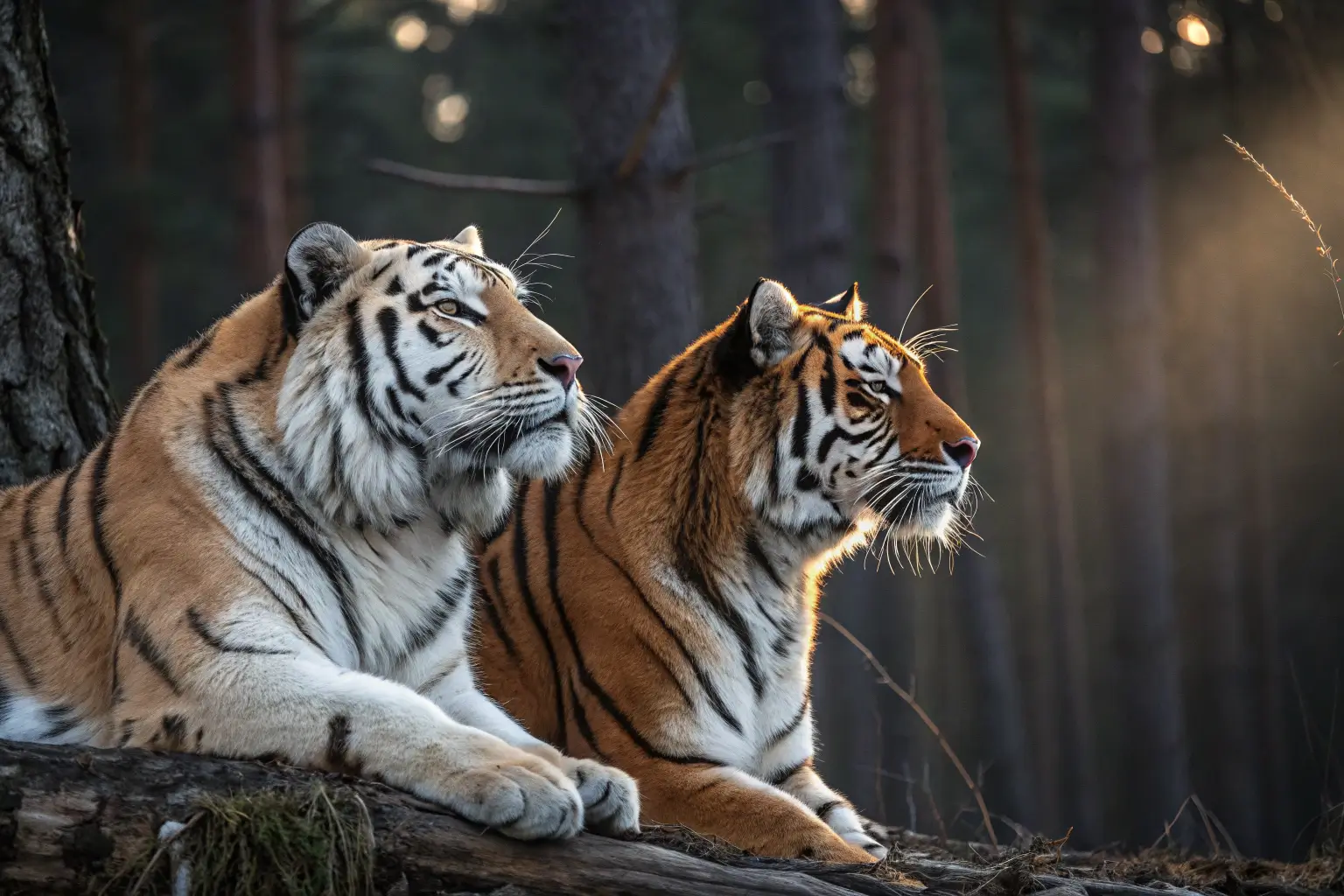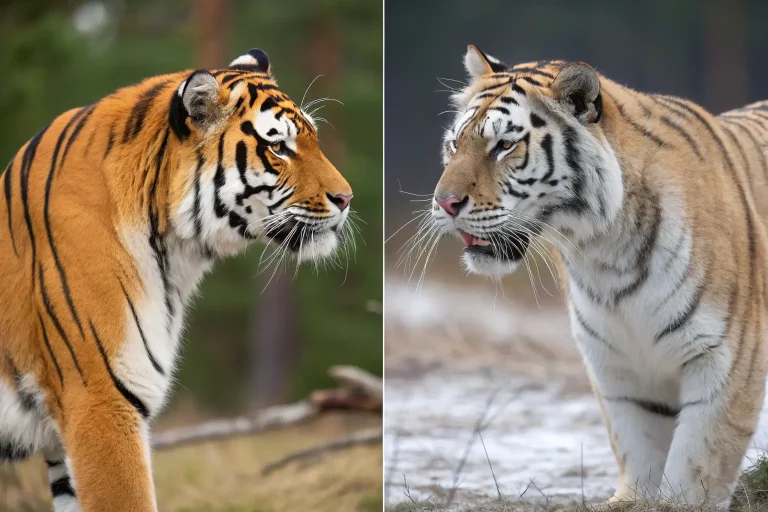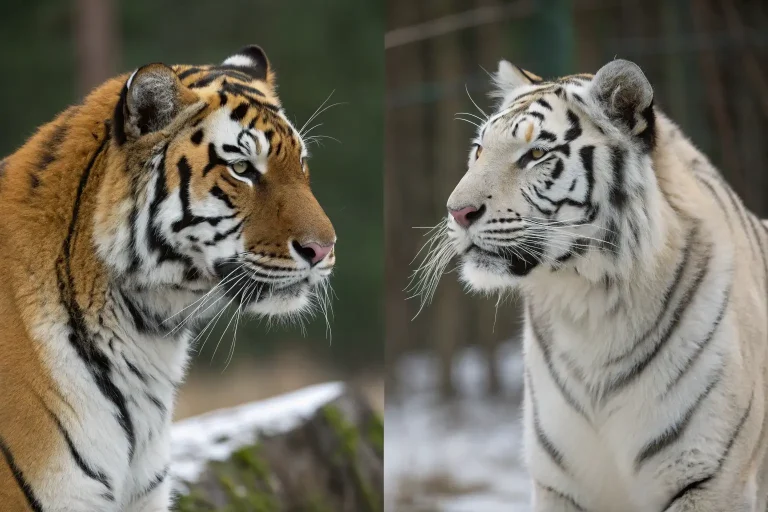Siberian vs Bengal Tiger: 7 Key Differences Revealed!
Do you know the differences between Siberian vs Bengal tiger populations in the wild? While both represent the largest living cat species on our planet, these magnificent predators have evolved distinct characteristics that set them apart. From their physical dimensions to habitat preferences, joining this ultimate tiger face-off will reveal the fascinating adaptations that have shaped these apex predators across different continents.
In this comprehensive guide, we’ll explore seven crucial differences between the Siberian and Bengal tigers. Whether you’re a wildlife enthusiast, conservation advocate, or simply curious about these majestic big cats, get ready to discover what makes each species uniquely adapted to their respective environments.
Introduction
Tigers captivate our imagination like few other creatures on Earth. As the largest living members of the cat family, they represent the perfect combination of power, stealth, and beauty. However, not all tigers are created equal. The Siberian vs Bengal tiger comparison reveals fascinating evolutionary adaptations that have occurred as these magnificent predators adapted to vastly different environments.
Understanding these differences isn’t merely academic—it’s critical for conservation efforts. With fewer than 4,500 tigers remaining in the wild, recognizing the unique challenges faced by different subspecies helps target protection strategies more effectively. As climate change and habitat loss continue to threaten their existence, knowledge becomes our most powerful weapon in the fight to preserve these iconic animals.
Did you know that if you placed a Siberian tiger and a Bengal tiger side by side, you could identify them almost immediately by their coloration alone? While both sport the iconic orange and black striped pattern, the differences in shade and stripe patterns tell a story of evolutionary adaptation spanning thousands of years.
Species Overview
Scientific Classification
Both the Siberian and Bengal tigers belong to the species Panthera tigris, but they represent different subspecies:
- Siberian Tiger: Panthera tigris altaica (also known as the Amur tiger)
- Bengal Tiger: Panthera tigris tigris
While they share the same species designation, genetic studies have confirmed these subspecies diverged approximately 110,000 years ago, developing distinct adaptations to survive in their respective habitats.
Physical Characteristics
When comparing Siberian vs Bengal tiger physical traits, several key differences emerge:
Siberian Tiger:
- Weight: Males 400-675 pounds (180-306 kg); Females 240-400 pounds (110-180 kg)
- Length: 10-12 feet (3-3.7 m) including tail
- Coat: Lighter orange with fewer, paler stripes
- Fur: Thick with dense undercoat (up to 2 inches thick in winter)
- Facial features: Broader face with prominent ruff around neck
Bengal Tiger:
- Weight: Males 400-550 pounds (180-250 kg); Females 220-350 pounds (100-160 kg)
- Length: 8-10 feet (2.4-3 m) including tail
- Coat: Deep, rich orange with darker, more numerous stripes
- Fur: Shorter, less dense coat
- Facial features: More streamlined face
The Siberian tiger generally possesses a bulkier frame with larger paws and thicker limbs—adaptations that aid survival in snowy conditions.
Subspecies Variations
The Bengal tiger shows remarkable variation within its population, including:
- Standard Bengal: The classic orange coat with black stripes
- White Bengal: A rare genetic variant with white fur and chocolate-brown stripes
- Golden Tabby: Extremely rare coloration with amber fur and pale tan stripes
Siberian tigers show less color variation but display greater size differences between geographical populations, with those in the northernmost regions typically growing larger.
Habitat and Distribution
Natural Habitat
Siberian Tiger:
The Siberian tiger has evolved to thrive in some of the harshest environments on Earth. These tigers make their homes in:
- Temperate broadleaf and mixed forests
- Boreal forests (taiga)
- Birch woodland
- Snow-covered landscapes for much of the year
Their territories often encompass remote mountainous areas with heavy snowfall, where temperatures can plunge to -50°F (-45°C). This extreme environment has shaped many of their distinctive physical adaptations.
Bengal Tiger:
In stark contrast, Bengal tigers inhabit:
- Tropical and subtropical moist broadleaf forests
- Mangrove swamps of the Sundarbans
- Dry forests and grasslands
- Areas with high humidity and temperatures often exceeding 104°F (40°C)
This warmer climate explains their shorter coat and more slender build compared to their northern counterparts.
Geographic Range
Siberian Tiger:
Once ranging throughout northeastern China, the Korean Peninsula, and much of eastern Russia, the Siberian tiger’s range has drastically contracted. Today, they’re primarily found in:
- Russian Far East (Primorye and Khabarovsk territories)
- Small pockets in China’s northeastern provinces
- Possibly a few individuals in North Korea
With only 500-550 individuals left in the wild, they occupy just 7% of their historical range.
Bengal Tiger:
Bengal tigers have a broader distribution, inhabiting:
- India (which holds 70% of the global population)
- Nepal
- Bangladesh
- Bhutan
- Small numbers in Myanmar
While more numerous (approximately 3,000 in the wild), the Siberian vs Bengal tiger population comparison reveals both subspecies face severe habitat fragmentation.
Adaptations
The Siberian vs Bengal tiger comparison reveals remarkable evolutionary adaptations:
Siberian Tiger:
- Thicker fur with an insulating fat layer (up to 2 inches thick)
- Larger paws that act like snowshoes
- More efficient fat storage for surviving food shortages
- Lighter coloration that provides better camouflage in snowy environments
- Typically larger size that reduces relative heat loss
Bengal Tiger:
- Shorter coat to manage tropical heat
- Darker, more numerous stripes that create better camouflage in dense jungle
- Smaller territories (as little as 8 square miles for females)
- Adaptations for swimming in mangrove habitats
- More varied diet reflecting diverse ecosystem
These adaptations highlight how each subspecies has evolved to maximize survival in dramatically different environments.
Diet and Feeding Habits

What They Eat
While both are apex predators, the Siberian vs Bengal tiger diet comparison reveals interesting differences:
Siberian Tiger:
- Primary prey: Manchurian wapiti, sika deer, wild boar
- Secondary prey: Musk deer, moose, Siberian roe deer
- Occasionally: Small mammals, bears, wolves, and fish
- Seasonal variations: Heavier reliance on large prey in winter
These tigers must consume approximately 20-30 pounds of meat daily during active periods and can eat up to 100 pounds in a single meal when food is abundant.
Bengal Tiger:
- Primary prey: Chital, sambar deer, wild boar
- Secondary prey: Gaur, water buffalo, nilgai
- Occasionally: Crocodiles, small elephants, rhino calves
- Regional variations: Fish and crabs in the Sundarbans
The average Bengal tiger consumes 15-25 pounds of meat daily with seasonal variations based on prey availability.
Hunting or Foraging Behavior
The hunting techniques of Siberian vs Bengal tigers reflect adaptations to their environments:
Siberian Tiger:
- Long-distance stalking (sometimes for miles)
- Greater reliance on ambush from forest cover
- Hunting often during daylight hours in winter
- Winter advantage: Prey animals struggle in deep snow while tigers can more easily traverse it
Bengal Tiger:
- Shorter stalking distances in denser vegetation
- Primarily nocturnal hunting
- More frequent use of water bodies for hunting and cooling
- Greater versatility in hunting techniques to match diverse habitats
Both subspecies can deliver a killing bite to the neck or throat, with enough force to sever the spinal cord of large mammals.
Dietary Needs
The nutritional requirements between Siberian vs Bengal tiger populations differ subtly:
Siberian Tiger:
- Higher caloric needs (especially in winter): 15,000-20,000 calories daily
- Greater fat consumption for insulation
- Seasonal gorging followed by periods of reduced activity
- Ability to fast for up to two weeks when necessary
Bengal Tiger:
- More consistent year-round caloric intake: 10,000-15,000 calories daily
- Higher water requirements in tropical climate
- More frequent but smaller meals
- Less pronounced seasonal feeding patterns
These dietary adaptations reflect not just prey availability but the metabolic demands imposed by their respective climates.
Behavior and Social Structure
Social Behavior
The social dynamics between Siberian vs Bengal tiger populations show both similarities and differences:
Siberian Tiger:
- Highly territorial with larger ranges (up to 1,000 square miles for males)
- More extensive territorial marking due to lower population density
- Less overlap between male territories
- Greater travel distances between encounters
Bengal Tiger:
- Slightly more tolerant of proximity to other tigers
- Smaller territories (50-75 square miles for males)
- More complex territorial dynamics where ranges frequently overlap
- Higher population density allows for more frequent interaction
Both subspecies remain primarily solitary, only coming together for mating, but the different population densities create distinct social dynamics.
Communication
Communication methods in the Siberian vs Bengal tiger comparison reveal interesting adaptations:
Siberian Tiger:
- Vocalizations can travel farther in cold, less humid air
- Scent marking persists longer in colder climates
- More reliance on visual signals in open snowy landscapes
- Lower frequency of vocal communication due to greater distances between individuals
Bengal Tiger:
- More frequent vocal communication
- Scent markers deteriorate faster in humid environments, requiring more frequent marking
- Complex array of vocalizations, including specific calls when hunting in water
- Adaptations for sound travel through dense vegetation
Both use similar communication tools—vocalizations, scent marking, scrapes, and body language—but adapt their usage to environmental conditions.
Mating and Reproduction
Reproductive behaviors in the Siberian vs Bengal tiger comparison show important differences:
Siberian Tiger:
- Breeding primarily occurs January-June
- Gestation: 3-3.5 months
- Average litter size: 2-4 cubs
- Sexual maturity: Females 3-4 years; Males 4-5 years
- Cubs remain with mother for up to 3 years
- Lower reproductive rate (females breed every 2-4 years)
Bengal Tiger:
- Can breed year-round, with slight preference for winter/spring
- Gestation: 3-3.5 months
- Average litter size: 2-6 cubs
- Sexual maturity: Females 3-4 years; Males 4-5 years
- Cubs typically independent at 1.5-2 years
- Slightly higher reproductive potential
The longer dependency period in Siberian tigers reflects the need for extended learning to master hunting in more challenging environments.
Conservation Status
Endangerment Level
Both subspecies face severe threats, though their conservation status differs slightly:
Siberian Tiger:
- IUCN Status: Endangered
- Population: Approximately 500-550 in the wild
- Trend: Stable to slightly increasing after reaching a low of 20-30 animals in the 1940s
- Faces extinction risk from small genetic pool and limited habitat
Bengal Tiger:
- IUCN Status: Endangered
- Population: Approximately 3,000 in the wild
- Trend: Stabilizing in some regions but declining in others
- Greater genetic diversity but facing rapid habitat fragmentation
The Siberian vs Bengal tiger conservation comparison shows that while Bengals have higher numbers, both remain perilously endangered.
Threats
Both subspecies face existential threats, though with regional variations:
Siberian Tiger:
- Poaching for traditional medicine (primarily bones and body parts)
- Habitat loss due to logging and resource extraction
- Prey depletion from illegal hunting
- Climate change affecting forest composition
- Genetic bottleneck from historical population decline
Bengal Tiger:
- Human-wildlife conflict in densely populated regions
- Extensive habitat fragmentation
- Poaching for skin and body parts
- Prey depletion
- Vulnerability to rising sea levels in mangrove habitats
The Siberian vs Bengal tiger threat assessment reveals that while specific pressures vary, both face human-driven extinction risks.
Conservation Efforts
Conservation strategies for Siberian vs Bengal tigers reflect their unique challenges:
Siberian Tiger:
- Russian-Chinese transboundary reserves
- Anti-poaching brigades in Russian Far East
- Prey species restoration programs
- Genetic monitoring and diversity preservation
- Reintroduction efforts in former range areas
Bengal Tiger:
- India’s Project Tiger (established 1973)
- Tiger corridor preservation initiatives connecting fragmented habitats
- Community-based conservation involving local stakeholders
- Advanced monitoring systems using camera traps
- Translocation programs to repopulate former habitats
While approaches differ, international collaboration remains essential for both subspecies’ survival.
Interesting Facts
When comparing Siberian vs Bengal tiger populations, these fascinating facts highlight their uniqueness:
Siberian Tiger:
- They can recognize individual humans and remember them for years
- Their roar can be heard up to 5 miles away
- They can leap up to 32 feet horizontally and 10 feet vertically
- Their night vision is six times better than humans
- They’ve been known to ambush hunters who were tracking them
Bengal Tiger:
- The white Bengal tiger occurs in approximately 1 in 10,000 births in the wild
- They have been documented killing crocodiles in water battles
- They’re excellent swimmers, capable of crossing rivers up to 5 miles wide
- The pattern of stripes on their skin (not just their fur) is unique like fingerprints
- They have been known to imitate the calls of prey animals to lure them closer
Both subspecies possess remarkable capabilities that have made them dominant predators in their ecosystems for thousands of years.
Tips for Caring for the Animal
While neither Siberian nor Bengal tigers should be kept as pets (it’s illegal in most countries and extremely dangerous), zoological institutions must address their distinct needs:
Siberian Tiger:
- Temperature considerations: Access to cool areas, even in temperate climates
- Dietary requirements: 15-20 pounds of meat daily with regular bone supplements
- Enrichment: Large territories (minimum 10,000 square feet) with varied terrain
- Health monitoring: Regular checking for joint issues common in large subspecies
- Behavioral management: Strong seasonal adjustments to care regimens
Bengal Tiger:
- Climate control: Access to shade and water features for cooling
- Nutrition: 10-15 pounds of meat daily with varied protein sources
- Habitat design: Swimming opportunities and vertical elements for climbing
- Medical care: Monitoring for parasites more common in tropical species
- Enrichment: Complex environmental features mimicking jungle habitats
The stark differences in Siberian vs Bengal tiger care requirements underscore their evolutionary divergence.
Role in the Ecosystem
Ecological Importance
As apex predators, both subspecies play crucial but somewhat different ecological roles:
Siberian Tiger:
- Population control of ungulates preventing forest degradation
- Regulation of mesopredator populations (wolves, etc.)
- Landscape of fear effects influencing prey distribution
- Carrion provision for scavenger communities in nutrient-poor northern forests
Bengal Tiger:
- Regulation of herbivore populations across diverse ecosystems
- Maintenance of species diversity through selective predation
- Movement pattern influence on prey adaptations
- Habitat engineering through predator-prey dynamics
The Siberian vs Bengal tiger ecological impact shows how each shapes their ecosystem in ways that maintain biological balance.
Impact of Decline
The loss of either subspecies would cascade through their ecosystems:
Siberian Tiger:
- Unchecked growth of deer populations leading to forest composition changes
- Mesopredator release (increase in smaller predators)
- Altered nutrient cycling in boreal forest systems
- Loss of evolutionary pressure on prey species
Bengal Tiger:
- Disruption of predator-prey relationships across multiple habitats
- Imbalance in herbivore populations affecting vegetation structure
- Reduced natural selection pressure on prey species
- Potential trophic cascades affecting species from insects to large mammals
The ecological consequences of losing either subspecies underscore the urgency of conservation efforts.
Conclusion
The Siberian vs Bengal tiger comparison reveals how two populations of the same species have evolved dramatically different characteristics to survive in vastly different environments. From the thick winter coat and larger size of the Siberian tiger to the more vivid coloration and diverse habitat adaptations of the Bengal tiger, these differences tell a fascinating story of evolutionary divergence.
Both subspecies stand as irreplaceable components of their ecosystems and cultural treasures for the countries where they remain. Yet both face unprecedented threats from habitat loss, poaching, and climate change. Their survival depends on coordinated conservation efforts, strong international cooperation, and public awareness.
By understanding what makes each subspecies unique, we can better appreciate the remarkable adaptability of these magnificent predators and strengthen our commitment to ensuring they continue to roam the Earth’s forests for generations to come. The preservation of both Siberian and Bengal tigers isn’t just about saving a species—it’s about maintaining the ecological integrity of some of our planet’s most precious wild landscapes.
Frequently Asked Questions
Which is bigger, a Siberian tiger or a Bengal tiger?
The Siberian tiger is generally larger than the Bengal tiger. Male Siberian tigers typically weigh 400-675 pounds (180-306 kg) and can reach lengths of 10-12 feet including their tail. Bengal tigers are slightly smaller, with males weighing 400-550 pounds (180-250 kg) and measuring 8-10 feet in length. The Siberian’s larger size is an adaptation to its colder habitat, following Bergmann’s rule that animals in colder climates tend to be larger to conserve heat.
Could a Siberian tiger survive in a Bengal tiger’s habitat and vice versa?
A Siberian tiger would struggle in a Bengal tiger’s tropical habitat. Their thick coat and fat layers would cause overheating in India’s hot climate. Conversely, a Bengal tiger could not naturally survive Siberian winters without their specialized cold-weather adaptations. Each subspecies has evolved specific traits for their native environment over thousands of years, making cross-habitat survival unlikely without human intervention.
Are Siberian tigers and Bengal tigers different species?
No, they are not different species but rather distinct subspecies of the same species, Panthera tigris. The Siberian tiger is classified as Panthera tigris altaica, while the Bengal tiger is Panthera tigris tigris. They diverged approximately 110,000 years ago but can still interbreed and produce fertile offspring when brought together in captivity.
Which tiger subspecies is more endangered?
While both are endangered, the Siberian tiger faces a more precarious situation with only 500-550 individuals remaining in the wild, primarily in Russia’s Far East. The Bengal tiger population is larger at approximately 3,000 individuals across India, Nepal, Bhutan, and Bangladesh. However, both subspecies face severe threats from poaching and habitat loss, placing them at significant risk of extinction.
Do Siberian and Bengal tigers have different hunting techniques?
Yes. Siberian tigers often track prey over long distances in sparse northern forests and have adapted to hunt in deep snow, where they have an advantage over ungulates that struggle in winter conditions. Bengal tigers typically employ shorter stalking distances in dense vegetation and have developed specialized techniques for hunting in water, particularly in the Sundarbans mangrove forests. These differences reflect adaptations to their distinct habitats.
Which subspecies has a better chance of long-term survival?
Currently, Bengal tigers have somewhat better prospects due to their larger population, greater genetic diversity, and more established conservation programs like India’s Project Tiger. However, Siberian tigers benefit from larger, more connected habitat blocks in the Russian Far East. Both face serious challenges, and their long-term survival depends on continued conservation efforts, habitat protection, and reduction of human-wildlife conflict.





